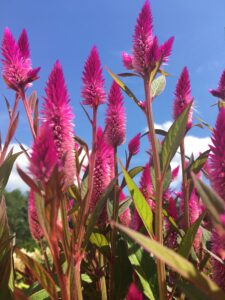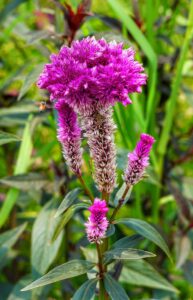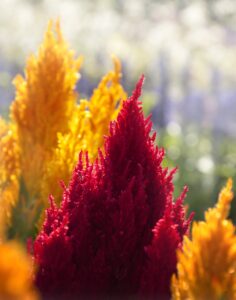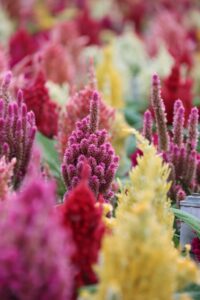Celosia flowers which is scientifically called celosia argentea, while commonly known as plumed celosia or feathered amaranth, is a captivating flowering plant that is widely cultivated for its stunning blooms and ornamental value. Native to tropical regions of Africa, this species has become popular worldwide due to its vibrant colors and unique feathery flower spikes.
The name “Celosia argentea” derives from the Greek word “kelos,” meaning “burned,” which refers to the fiery, flame-like appearance of its flowers. The species name “argentea” relates to the silver-colored sheen of the plant’s leaves and stems.
Plumed celosia plants typically grow to a height of around 1 to 3 feet (30 to 90 centimeters), with erect stems that bear elongated flower spikes. The flowers are densely packed along the spike and form feathery plumes, giving rise to their common name. The individual flowers can range in color from vibrant shades of red, pink, orange, yellow, and purple, adding a burst of color to any garden or floral arrangement.
Due to its striking appearance and long-lasting quality, Celosia argentea is widely used in gardens, containers, and flower beds to create vibrant displays. It also makes an excellent choice for cut flower arrangements, as the blooms retain their color and shape even after being dried. Dried celosia flowers are often used in crafts, wreaths, and dried flower bouquets.
It has an upright growth habit, with sturdy, erect stems that support the flower spikes. Celosia flowers typically grow to a height of 1 to 3 feet (30 to 90 centimeters), though certain cultivars can be taller.

The leaves of Celosia flowers are broad and lance-shaped, measuring about 3 to 6 inches (7 to 15 centimeters) in length. They are usually green in color, but some varieties may have reddish or bronze tones. The leaves have a smooth or slightly waxy texture.
The most distinctive feature of Celosia flowers is its vibrant, plumed flowers. The flowers are densely packed along elongated, erect spikes, creating a feathery or flame-like appearance. The individual flowers are tiny and inconspicuous, but when combined, they form showy plumes of color. The flower colors can range from rich shades of red, pink, orange, yellow, and purple. Some cultivars may also display bicolor or multicolored blooms.
Celosia argentea typically blooms from late spring to fall, depending on the climate and growing conditions. The flowers are long-lasting and maintain their vibrant colors for an extended period, both on the plant and after they are cut and dried.
Cultivars of Celosia Flowers
Celosia argentea, or plumed celosia, has numerous cultivars available, each with its unique characteristics. Here are some popular cultivars of Celosia argentea:
Celosia argentea ‘Cramer’s Amazon’: This cultivar features large, upright plumes of deep red flowers. It has sturdy stems and dark green leaves, providing a striking contrast to the vibrant blooms.
Celosia argentea ‘New Look’: Known for its exceptionally large flower heads, ‘New Look’ produces stunning plumes in various colors, including vibrant shades of red, pink, orange, and yellow. The blooms are held above lush green foliage.
Celosia argentea ‘Cramers’ Lemon Lime’: This cultivar offers a unique twist with its chartreuse-colored plumes. The feathery flower spikes stand out against the dark green foliage, creating a striking visual contrast.
Celosia argentea ‘Flamingo Feather’: ‘Flamingo Feather’ is characterized by its soft, pink-colored plumes. The flowers resemble fluffy feathers and provide an elegant touch to garden beds and containers.
Celosia argentea ‘Fresh Look Red’: This cultivar produces vibrant, bright red flower spikes that are thicker and more compact compared to some other varieties. The blooms have a velvety appearance and are held above green foliage.
Celosia argentea ‘Kimono Mix’: ‘Kimono Mix’ showcases a blend of colorful plumes, including shades of red, pink, orange, and yellow. This cultivar offers a beautiful range of hues, adding a captivating display of colors to gardens and flower arrangements.
Celosia argentea ‘Flamingo’: ‘Flamingo’ is known for its delicate, pastel-pink flowers. The plumes have a feathery texture, creating an airy and graceful display.
Celosia argentea ‘Century Mix’: This cultivar produces a mix of vibrant flower colors, including shades of red, orange, pink, and yellow. The blooms are held atop strong stems and are complemented by green foliage.



These are just a few examples of the many cultivars available within the Celosia argentea species. Each cultivar offers its own unique flower color, size, and shape, providing a diverse range of options to suit various garden designs and preferences.
Sunlight Requirement of Celosia flowers
Celosia flowers, or plumed celosia, thrive in full sun conditions. It is a sun-loving plant that requires a minimum of 6 hours of direct sunlight per day to grow and flower optimally. Place Celosia flowers in a location where they can receive maximum sunlight throughout the day. Choose a spot in your garden or landscape that is not shaded by trees, buildings, or other structures. In hot climates or during scorching summers, some protection from intense afternoon sun or excessive heat may be beneficial. Partial shade during the hottest part of the day can help prevent stress and minimize wilting.
Temperature and Humidity Requirements:
Celosia flowers is a warm-season plant that thrives in temperatures between 70°F and 85°F (21°C to 29°C). It is highly adapted to tropical and subtropical regions. While Celosia argentea flowers prefer warm temperatures, they can also tolerate slight fluctuations. However, extreme temperature variations or prolonged exposure to temperatures above 90°F (32°C) can lead to stress, reduced flowering, and diminished overall health. Provide some shade or protective measures during excessively hot periods to prevent heat stress. Celosia flower is susceptible to frost and cannot tolerate freezing temperatures.
Celosia argentea prefers moderate to high humidity levels. It originates from tropical regions where humidity is relatively high. Aim for a humidity range between 50% and 70% for optimal growth. Proper air circulation is also necessary.
When growing Celosia flowers indoors, especially in drier environments, you can increase humidity by using methods such as misting the plants with water or placing a tray of water near the plants. This helps create a microclimate with slightly higher humidity levels.

Soil Requirement of Celosia Flowers
Celosia flowers have specific soil requirements to thrive. They prefer well-draining soil that is rich in organic matter. Celosia plants do not tolerate waterlogged or heavy clay soils. Ensure the soil drains well to prevent root rot and other water-related issues. If you have heavy clay soil, consider amending it with organic matter or sand to improve drainage. Loamy soil is ideal for Celosia. It has a balanced mixture of sand, silt, and clay, providing good drainage while retaining some moisture and nutrients. Celosia flowers prefer slightly acidic to neutral soil with a pH range of 6.0 to 7.0. You can test your soil’s pH and adjust it if necessary using lime to raise pH or sulfur to lower it.
Before planting Celosia seeds or seedlings, prepare the soil by digging it to a depth of 6-8 inches. Remove weeds, rocks, and debris, and work on the organic matter and any necessary amendments.
If you’re growing Celosia in containers, use a well-draining potting mix that is designed for flowering annuals. Container-grown Celosia requires good drainage to prevent root issues.
Remember that good soil preparation is key to growing healthy Celosia plants. Proper soil ensures they have the right environment to establish strong roots and produce vibrant flowers. Additionally, maintaining soil quality with regular fertilization and mulching will support their growth throughout the growing season.
Propagation of Celosia flowers through Seed Sowing
Celosia flowers, or cockscomb or woolflowers, can be propagated through seeds. Here’s a step-by-step guide on how to propagate Celosia flowers from seeds:
You can start Celosia seeds indoors in late winter or early spring or directly sow them outdoors after the last frost. If starting indoors, use seed trays or small pots filled with a well-draining potting mix.
Sow the Celosia seeds indoors on the surface of the potting mix. Press them down gently into the soil but do not cover them with soil, as Celosia seeds require light to germinate.
For outdoors sow the seeds about 1/4 inch deep in the garden soil, spaced about 6-12 inches apart.
Celosia seeds germinate best at a temperature of around 70-75°F (21-24°C).
As mentioned earlier, Celosia seeds need light to germinate, so make sure they receive indirect sunlight.
Keep the soil consistently moist but not waterlogged. Water the seeds gently to avoid dislodging them.
If started indoors, once the seedlings have grown large enough and outdoor conditions are suitable, you can transplant them into your garden or larger containers. Be sure to harden off the seedlings by gradually exposing them to outdoor conditions over a few days to prevent shock.
If you have sown multiple seeds in the same spot, thin the seedlings to leave the healthiest ones. Typically, you should have one strong Celosia plant every 6-12 inches.
Remember that Celosia flowers are typically easy to grow from seed, and with proper care, they can provide vibrant and unique blooms in your garden.
Water requirements of Celosia flower
Celosia argentea flowers prefer moist soil that is well-draining. It is important to maintain a balance in soil moisture, ensuring that the plant does not experience prolonged periods of waterlogged conditions. Allow the top inch (2.5 centimeters) of soil to dry out slightly between watering. Water deeply, ensuring the water penetrates the root zone. Waterlogged soil can lead to root rot and other problems. Avoid planting Celosia flowers in heavy clay soils or areas prone to poor drainage. Watering in the early part of the day allows the foliage to dry before evening, reducing the risk of fungal diseases.
If growing Celosia flowers in containers, they may require more frequent watering compared to plants in the ground. Containers tend to dry out more quickly, especially during hot weather. Check the moisture level in the container through this procedure.

Fertilizer Requirement of Celosia flower
Fertilizing Celosia flowers is important to support their growth and encourage vibrant blooms. Use a balanced, water-soluble fertilizer with equal N-P-K (Nitrogen, Phosphorus, Potassium) ratios or a slow-release granular fertilizer with a similar N-P-K composition (e.g., 10-10-10 or 14-14-14).
Alternatively, you can use a specialized flower or general-purpose fertilizer that provides the necessary nutrients for overall plant health. Fertilize Celosia at planting or sowing time to provide the initial nutrients needed for healthy seedling development. Apply a balanced fertilizer every 4-6 weeks during the growing season. This helps maintain continuous growth and flowering.
Over-fertilization can lead to excessive growth, weak stems, and reduced flowering. Always follow the recommended dosage on the fertilizer package.
Periodically test your soil to determine its nutrient levels and pH. This can help you adjust your fertilization program to meet the specific needs of your Celosia plants.
Remember that consistent and appropriate fertilization is essential for the healthy growth and abundant flowering of Celosia.
Problems While growing Celosia flower
While Celosia flowers are relatively easy to grow, they can encounter some common problems and challenges. Here are some issues you might face and how to address them:
Disease and Fungal Issues:
Powdery Mildew: This white, powdery substance on the leaves is a sign of powdery mildew. Improve air circulation, avoid overhead watering, and use a fungicide as a preventive measure.
Gray Mold (Botrytis): Gray mold can occur in wet and cool conditions. Remove affected plant material, and ensure good air circulation.
Pests:
Aphids, Whiteflies, and Spider Mites: These tiny pests can damage Celosia leaves and flowers. Use insecticidal soap or neem oil to control them.
Slugs and Snails: They can chew on the leaves and flowers. Use traps or baits to control them.
Poor Growth or Flowering:
Celosia generally requires full sun. If they are not flowering well, ensure they receive at least 6-8 hours of direct sunlight each day. Celosia plants need space to grow and good airflow. Overcrowding can lead to poor growth and increased disease susceptibility.
Overwatering or Waterlogged Soil:
Celosia prefers consistently moist but not waterlogged soil. Make sure your planting area has well-draining soil, and water the plants appropriately. Soggy soil can lead to root rot.
Extreme Weather Conditions:
Celosia can be sensitive to extreme heat or cold. Protect the plants from intense sun and heat by providing some shade during the hottest part of the day. If frost is expected, cover the plants or bring them indoors.
Uses of Celosia Flowers
Celosia flowers, also known as plumed celosia or feathered amaranth, are highly valued for their ornamental beauty and are commonly used in various decorative applications. Here are some of the ornamental uses of Celosia argentea flowers:
Garden Borders and Bedding: The vibrant and unique appearance of Celosia flowers makes them a popular choice for garden borders and bedding plants. They add a burst of color and texture, creating focal points and attracting attention in garden landscapes.
Container Gardens: Celosia flowers are well-suited for container gardening, making it a favorite choice for potted plants and hanging baskets. The striking plumed flowers provide a vertical element and add a pop of color to patio areas, balconies, and decks.

Cut Flower Arrangements: Celosia flowers are often used in cut flower arrangements due to their long-lasting nature. Their vibrant colors and unique flower structures make them an eye-catching addition to bouquets and floral displays like with Stock flowers. They add texture, interest, and a touch of whimsy to both formal and informal arrangements.

Dried Flower Crafts: Celosia flowers have excellent drying characteristics, retaining their color and shape even after drying. This makes them ideal for dried flower crafts, wreaths, and arrangements. The feathery plumes and vibrant hues of dried celosia flowers bring texture and visual appeal to home décor projects.

Landscape Design: Celosia argentea is often used in landscape design to create visually stunning displays. The tall, upright plumes of flowers add vertical interest and can be strategically placed to create focal points or provide a backdrop for other garden plants.
Flower Beds and Mass Plantings: Celosia flowers are well-suited for mass plantings in flower beds, creating a vibrant carpet of color. They can be used alone or combined with other annuals or perennials to create dynamic and visually appealing flower displays.
Edging and Borders: The compact varieties of Celosia argentea are particularly suitable for edging and border plants. Their low-growing habit and vibrant flowers add definition and color to garden pathways, borders, and garden bed edges.
The ornamental uses of Celosia flowers are diverse, ranging from garden landscaping to floral arrangements and crafts. Their vibrant colors, unique plume-like structures, and long-lasting quality make them a versatile and visually captivating choice for ornamental purposes.




